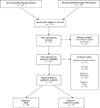Electronic nicotine delivery systems ("e-cigarettes"): review of safety and smoking cessation efficacy
- PMID: 24898072
- PMCID: PMC4376316
- DOI: 10.1177/0194599814536847
Electronic nicotine delivery systems ("e-cigarettes"): review of safety and smoking cessation efficacy
Abstract
Background and objectives: Cigarette smoking is common among cancer patients and is associated with negative outcomes. Electronic nicotine delivery systems ("e-cigarettes") are rapidly growing in popularity and use, but there is limited information on their safety or effectiveness in helping individuals quit smoking.
Data sources: The authors searched PubMed, Web of Science, and additional sources for published empirical data on safety and use of electronic cigarettes as an aid to quit smoking.
Review methods: We conducted a structured search of the current literature up to and including November 2013.
Results: E-cigarettes currently vary widely in their contents and are sometimes inconsistent with labeling. Compared to tobacco cigarettes, available evidence suggests that e-cigarettes are often substantially lower in toxic content, cytotoxicity, associated adverse effects, and secondhand toxicity exposure. Data on the use of e-cigarettes for quitting smoking are suggestive but ultimately inconclusive.
Conclusions: Clinicians are advised to be aware that the use of e-cigarettes, especially among cigarette smokers, is growing rapidly. These devices are unregulated, of unknown safety, and of uncertain benefit in quitting smoking.
Implications for practice: In the absence of further data or regulation, oncologists are advised to discuss the known and unknown safety and efficacy information on e-cigarettes with interested patients and to encourage patients to first try FDA-approved pharmacotherapies for smoking cessation.
Keywords: carcinogens; e-cigarettes; electronic nicotine delivery systems; nicotine; personal vaporizers; smoking; toxicity; vapers; vaping.
© American Academy of Otolaryngology—Head and Neck Surgery Foundation 2014.
Conflict of interest statement
The other authors report no conflict of interest.
Figures
Similar articles
-
Correlates of use of electronic cigarettes versus nicotine replacement therapy for help with smoking cessation.Addict Behav. 2014 Dec;39(12):1869-73. doi: 10.1016/j.addbeh.2014.07.034. Epub 2014 Aug 7. Addict Behav. 2014. PMID: 25129173 Free PMC article.
-
E-cigarette versus nicotine inhaler: comparing the perceptions and experiences of inhaled nicotine devices.J Gen Intern Med. 2014 Nov;29(11):1444-50. doi: 10.1007/s11606-014-2889-7. Epub 2014 May 15. J Gen Intern Med. 2014. PMID: 24830741 Free PMC article. Clinical Trial.
-
Are electronic nicotine delivery systems (ENDs) helping cigarette smokers quit?-Current evidence.J Oral Pathol Med. 2020 Mar;49(3):181-189. doi: 10.1111/jop.12966. Epub 2019 Nov 8. J Oral Pathol Med. 2020. PMID: 31642553 Review.
-
Vaping versus Smoking: A Quest for Efficacy and Safety of E-cigarette.Curr Drug Saf. 2018;13(2):92-101. doi: 10.2174/1574886313666180227110556. Curr Drug Saf. 2018. PMID: 29485005 Review.
-
The Role of Nicotine Dependence in E-Cigarettes' Potential for Smoking Reduction.Nicotine Tob Res. 2018 Sep 4;20(10):1272-1277. doi: 10.1093/ntr/ntx160. Nicotine Tob Res. 2018. PMID: 29065204 Free PMC article.
Cited by
-
Promotion of a Protease-Antiprotease Imbalance in the Airways through Chronic Vaping.Am J Respir Crit Care Med. 2019 Dec 1;200(11):1337-1339. doi: 10.1164/rccm.201908-1605ED. Am J Respir Crit Care Med. 2019. PMID: 31496259 Free PMC article. No abstract available.
-
E-cigarette use and its predictors: Results from an online cross-sectional survey in Poland.Tob Induc Dis. 2019 Nov 8;17:79. doi: 10.18332/tid/113093. eCollection 2019. Tob Induc Dis. 2019. PMID: 31772557 Free PMC article.
-
What factors predict the passage of state-level e-cigarette regulations?Health Econ. 2018 May;27(5):897-907. doi: 10.1002/hec.3642. Epub 2018 Feb 22. Health Econ. 2018. PMID: 29468781 Free PMC article.
-
Smoking and Male Infertility: An Evidence-Based Review.World J Mens Health. 2015 Dec;33(3):143-60. doi: 10.5534/wjmh.2015.33.3.143. Epub 2015 Dec 23. World J Mens Health. 2015. PMID: 26770934 Free PMC article. Review.
-
The efficacy and short-term effects of electronic cigarettes as a method for smoking cessation: a systematic review and a meta-analysis.Int J Public Health. 2016 Mar;61(2):257-67. doi: 10.1007/s00038-016-0786-z. Epub 2016 Jan 29. Int J Public Health. 2016. PMID: 26825455
References
-
- U.S. Department of Health and Human Services. The Health Consequences of Smoking – 50 Years of Progress: A Report of the Surgeon General. Atlanta, GA: U.S. Department of Health and Human Services, Centers for Disease Control and Prevention, National Center for Chronic Disease Prevention and Health Promotion, Office on Smoking and Health; 2014. - PubMed
-
- Blot WJ, McLaughlin JK, Winn DM, et al. Smoking and drinking in relation to oral and pharyngeal cancer. Cancer research. 1988;48(11):3282–3287. - PubMed
Publication types
MeSH terms
Grants and funding
LinkOut - more resources
Full Text Sources
Other Literature Sources
Medical



